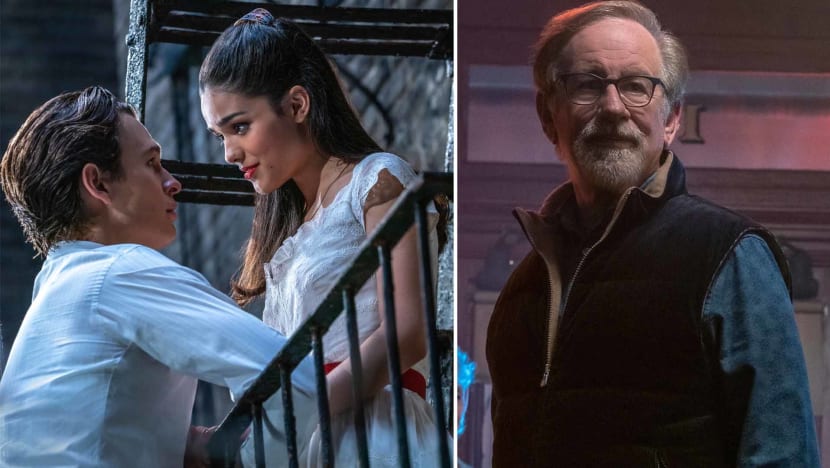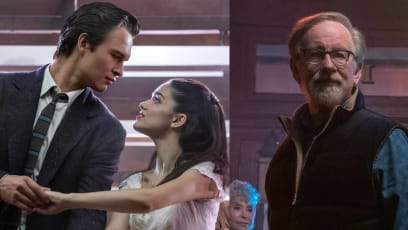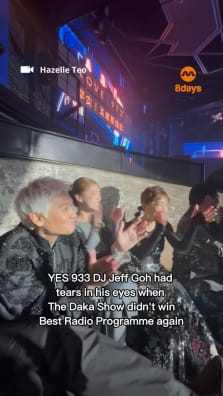“Frustrated Musical Director” Steven Spielberg Calls New Version Of West Side Story “A Cautionary Tale”
Steven Spielberg's latest is a reimagining of the 1961 Oscar-winning musical 'West Side Story'.

George Lucas once called his pal Steven Spielberg “a frustrated musical director.”
“I don’t know where he got that idea,” says Spielberg, 75, with a chuckle.
“I think it was because I was always talking about [legendary musical figures] Busby Berkeley, Gene Kelly, Stanley Donen and Vincent Minnelli and it got to a point where he just said, ‘Well, why don’t I create a musical number at the beginning of [Indiana Jones and the] Temple of Doom and we’ll put the titles over it and you can shoot a musical number.”
The result: a cover of Cole Porter’s ‘Anything Goes’ by Kate Capshaw (aka Mrs Steven Spielberg). The song was done in Mandarin (because the scene took place in a 1930s Shanghai club), or rather what sounded like Mandarin. In fact, we still have no idea what language she sang in. Anyhoo, but that’s another question for another time.
For Spielberg, it wasn’t until nearly four decades later that he would attempt another musical — his career first — on the big screen: a remake of Robert Wise and Robbins’ West Side Story, the 1961 Best Picture Oscar winner (and in nine other categories, including Best Director), in turn inspired by William Shakespeare’s Romeo and Juliet and featuring the unforgettable music by Leonard Bernstein and lyrics by Stephen Sondheim.
The story follows two youngsters, Tony (The Fault in our Stars’ Ansel Egort), and Maria (newcomer Rachel Zegler) from rival New York City gangs — the Jets and the Sharks, respectively — fall in love, but tensions between their respective friends build toward tragedy. Rita Moreno, who won a Best Supporting Actress Oscar for the original film, also appears in the latest iteration.
Why would Spielberg tamper with a classic? (FYI: The ‘Berg is no stranger to remakes: 1989’s Always, starring Holly Hunter and Richard Dreyfuss, is a re-do of 1943’s Spencer Tracy-headlined A Guy Named Joe. Besides the aforementioned Temple of Doom sequence, Spielberg was also a producer on the musical-themed series Smash.)
For a few reasons. First, this West Side Story isn’t a remake of the 1961 version. Well, not directly. Instead, Spielberg and his Lincoln and Munich collaborator, screenwriter Tony Kushner, took inspiration from the 1957 Broadway musical that started it all.
Second, Spielberg grew up listening to West Side Story. “‘Gee, Officer Krupke’ was the first song I memories when I was a 10-year-old kid,” Spielberg tells 8days.sg and other journos over Zoom from Los Angeles of him being mesmerised by the soundtrack. “Just listening to that New York Philharmonic play those huge orchestral themes that almost sounded like a celebration, and on the other hand a funeral, a memorial — the music went from joy to deep tragic sorrow.”
“When I started having children, I have all these home movies of my kids growing up and we’re all running around the house on weekends doing on the numbers from West Side Story,” says Spielberg who has seven children. “I’ve got all my kids playing [the main characters] and lip-synching to the original Broadway score!”
And three, Spielberg got to right a few wrongs committed by his predecessor. While the West Side Story 1.0 was critically acclaimed, it was far from perfect: it drew a lot of flak for casting white actors — including Natalie Wood — to play the Puerto Rican characters. In Spielberg’s version, however, all the Sharks boys and girls were 100 percent Latinx.
Elsewhere, while West Side Story is still set in 1957, Spielberg hopes the film’s issues — such as racism, xenophobia, the legacies of colonialism, the effects of poverty, gang warfare and disillusionment with the American Dream — will resonate with younger audiences, especially those have heard of neither the 1957 stage production nor the 1961 adaptation.
Here are three takeaways about West Side Story from our 15-minute roundtable — which took place a few weeks before Sondheim's passing at age 91— with the Oscar-feted filmmaker.
1. The camera is a new character.
“All directors put their marks on whatever they direct, whether it’s a limited series, a big cable series, a feature film or a TV movie. Whatever it is, it happens over the process of developing the script, the casting, every time we make a choice, we’re putting our stamp on the subject matter, and so by the time you get to the end of it, that’s when you realise some of the pollen rubbed off on the film. But it isn’t ever just any one thing. If there was any one choice I made differently than I’ve ever imagined making as a filmmaker, it was that I wanted the camera to be a character. I wanted the camera to be a dancer, an actor, a singer. I did not want to film the story against a proscenium, the way so many musicals are shot. I wanted the camera to be inside the dance, inside those rooms, and circling around the people. The camera needed to have a function more than just as an observer. The camera needed to be an active participant.”
2. The new West Side Story is more cinematic than the 1961 version.
“I also felt that the audience today is very demanding of authenticity, and of a kind of demand which I certainly had for diversity. A demand that this needed to be an authentic representation of the Nuyorican and Puerto Rican experience. And I wasn’t trying to make up for anything that history has done with the play or the film because these were all different times. Obviously, there’s a lot more sensitivity today than there had ever been before throughout Hollywood history. But I felt that in the effort to make this a street musical and not a theatrical musical. The West Side Story movie that I love so much, made by Robert Wise and Jerome Robbins, is a hybrid between cinema and theatre. But I wanted this just to be cinema. Therefore, it made it a prerequisite that everything has to be more realistic. The characters have to be deeper, more inter-relational, more interpersonal, and the rage and the hate have to be much more pronounced and not safe at all.”
3. The movie is really about the importance of listening.
“I’ve always felt that the effort to have a conversation, is simply to sit down and have a conversation as opposed to violently or ideologically stating your position without bringing your ears to the discussion. I think that’s the initial problem with the Sharks and the Jets, and a problem that we see happening every single day, and has been for many, many years in this country. That there is less listening and more stating of one’s position. I think although there was no racial component in Romeo and Juliet where there is with West Side Story, I really feel that there would have been a different outcome had Tony been at the first war council in West Side Story. Of course, there’s no drama if you do that. But just to make my point, I always hoped it would be a cautionary tale, that we just need to get into rooms with people we don’t agree with, and talk about everything."
West Side Story (PG13) is now in cinemas.
Photos: 20th Century Studios


















![Boss of Rui Ji chicken rice used to own a tattoo parlour! Talk about a career change! Link in bio to read more
📍Rui Ji Chicken Rice
Blk 93 Toa Payoh Lor 4,
#01-48, S310093
📍148 Beach Road,
#B1-01 The Gateway,
S189720
📍Blk 305 Ubi Ave 1,
#01-179, S440305
[till 16 Apr 2024]
https://tinyurl.com/5dudypkh](https://onecms-res.cloudinary.com/image/upload/s--9s0hbGvI--/c_fit,h_396,w_223/f_auto,q_auto/v1/8days-migration/18015522113203478.jpg?itok=EX3xKSNq)






![We stan a kind-hearted boss with a good heart! 💕 Link in bio to read more
📍Rui Ji Chicken Rice
Blk 93 Toa Payoh Lor 4,
#01-48, S310093
📍148 Beach Road,
#B1-01 The Gateway,
S189720
📍Blk 305 Ubi Ave 1,
#01-179, S440305
[till 16 Apr 2024]
https://tinyurl.com/5dudypkh](https://onecms-res.cloudinary.com/image/upload/s---y3eV-Ts--/c_fit,h_396,w_223/f_auto,q_auto/v1/8days-migration/17999638880322602.jpg?itok=Tiqm3SVR)



